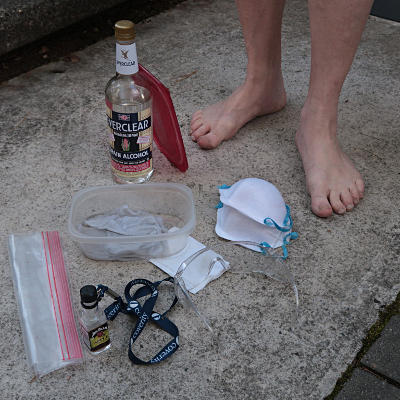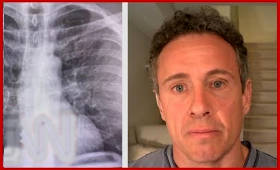In the US, this left the barefooter community wondering if there would be so much irrational fear in the streets that they'd never be able to safely barefoot again without facing a hysterical lynch mob. What seems to be emerging is encouragingly opposite: the science behind how long infectious virus particles can remain viable on different surfaces turns out to be in favor of bare human skin. And our skin is far easier to clean and sanitize than clothing and shoes.
Kriss, one of the leading lights of the SBL, soon saw a need for public education. He posted an in-depth blog entry on the topic, referencing a study in the New England Journal of Medicine and some other sources. Days-long virion viability on metal and plastic clearly dooms things like door handles and public transit to be long-lived contact vectors, whereas the cardboard and paper arriving on the doorstep from Amazon and grocery deliveries and mail are a threat for somewhat less time. People are learning to be careful about outside material brought into the home, how to treat it, and how long it may remain suspect. But other than floors, we touch none of that with our feet, and when we're concerned about what's on floors we walked on, it's easy enough to sanitize our soles when appropriate. People rarely if ever wash their shoes, and yet handle them repeatedly in the process of daily living. Conclusion: better to simply go without, regard our feet as our other two hands, and remain keenly aware of what all four of those extremities come in contact with.
Despite isolation and distancing guidelines, we still need to go out for supplies, and we can sensibly use science to protect ourselves in the process. To that end, here is my "covid kit" for the road, particularly when intending to be in a closed space near other people such as a store.

This is based around 95% pure grain alcohol, commonly available in many liquor stores despite severe shortages in commercial hand sanitizer and isopropyl rubbing alcohol. Cut with a little water to about 80% alcohol content, the Everclear mix is well over the 60% threshold to dissolve coronavirus lipid envelopes and provides a little "hang time" to finish its virus-busting before evaporating away. [Rubbing alcohol will still work too; it is typically around 70% concentration.] Less viscosity than typical hand-sanitizer gel also allows an alcohol solution to flow more easily into crevices and do its work. Here we see the following components:
- A small "nip" bottle of the alcohol mix carried on a neck lanyard, so it's always immediately available for hand sanitization on the spot. The lanyard gives a "third arm" for easier manipulation. [And it's ironically hilarious that the old trade-show lanyard I grabbed first is from "Coverity"...]
- A food storage container with tight-fitting lid, with about a half-inch of the same mix in the bottom and some paper towel pieces immersed, for wiping down items. This can be used over and over again, with occasional top-up as the content is slowly lost. This can also be used for cleaning feet
- A couple of generic shop dust masks. These are not N95 or surgical grade, but still effectively impede airflow to and from the mouth and nose. Consensus is slowly emerging (particularly in the US) that *something* is better than nothing in a public environment. (see below)
- Wraparound safety glasses, to help keep flying droplets/aerosols [and our fingers!] away from the eyes
- A Ziploc bag for store cashiers to drop change and receipts into if necessary, isolating it away from my wallet for subsequent mitigation
- Appropriate safety footwear
At the respiratory end of the body, however, the story is different. Various eastern Asian cultures have long understood the benefits of filtering face masks, even crude homemade types, for helping contain airborne pathogen spread in public settings. At this time the CDC is finally taking this professor's advice and is close to encouraging their widespread use in the US and elsewhere, especially right now while the world needs to get a handle on curbing the exponential spread of the virus while continuing to (barely) function. A generic fiber mask can be soaked in the alcohol mix to deactivate whatever may have landed on it, dried out, and safely reused.
Perhaps the CDC should endorse leaving the shoes at home too, for the evident safety benefits over footwear made from synthetic plastics and rubber. The difference in adhered coronavirus viability is minutes versus days, and minutes essentially drop to zero on simple application of our "killer mix".
 If anyone has lent us unwavering confidence in the still-worsening crisis,
it's the Cuomo brothers in New York -- Andrew as the governor, for his calm
and even-handed management of the US epicentre, and Chris for his in-depth
documentation of his own experience fighting the disease itself while
still doing his CNN shows from his basement quarantine.
Chris recommends that we can and should take charge of our own health
in a holistic way, and possibly the best manifestation of that is
If anyone has lent us unwavering confidence in the still-worsening crisis,
it's the Cuomo brothers in New York -- Andrew as the governor, for his calm
and even-handed management of the US epicentre, and Chris for his in-depth
documentation of his own experience fighting the disease itself while
still doing his CNN shows from his basement quarantine.
Chris recommends that we can and should take charge of our own health
in a holistic way, and possibly the best manifestation of that is